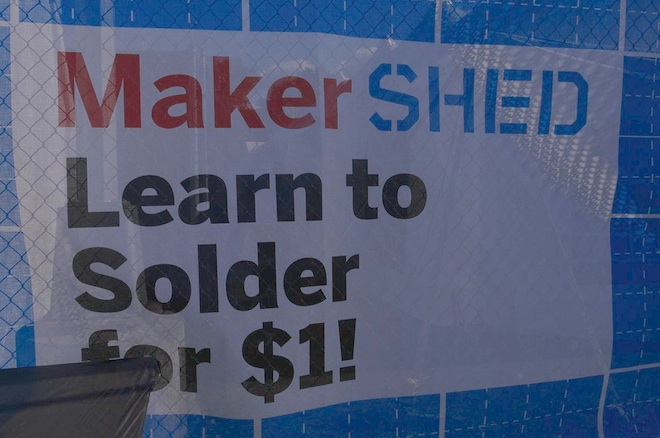By Emily Gertz
Take the pride on display at a classic American county fair. Mix in a big helping of happy enthusiasm for science, and fold in some “hey, why not?” attitude. Top it all off with a joyful embrace of the absurd.
What you get is Maker Faire, an annual series of family-friendly sci-tech-engineering festivals held in cities around the country. The fest exists to celebrate and expand the “maker” (sometimes called “hacker”) movement of DIY electronics and open-source technology.
This year’s festival in New York City, held September 17-18, was only the city’s second. The maker (read: hobby or semi-pro electronics) scene has emerged relatively recently in NYC, compared to cities like Boston, San Francisco and Austin.
But what Gotham may have lacked in early adopter cred, it has made up by being home to three unique and influential alterna-tech entities, all present at the Maker Faire: the Eyebeam Art+Technology Center, a non-profit incubator for cutting edge media art; NYU’s graduate Interactive Telecommunications Program (ITP), which trains communications professionals and artists alike in innovating with digital and electronic technologies; and Etsy, arguably the leading online marketplace for craftspeople and independent artists to sell their goods to the general public.
This year’s festival, held at the New York Hall of Science in Queens, was much like last year’s in featuring a great many things made simply for fun:
-Bicycles mashed up with shopping carts to create unique human-powered rides.
-A T-Rex-sized, fire-breathing dragon welded from scrap metal.
-Tabletop robots shaped like insects (created by members of “hacker spaces” in and around the New York metro area).
– Desktop laser cutters and fabricators, as well as many, many small devices made using the compact, inexpensive Arduino computer board.
-An “art car” covered with those weird semi-robotic singing fish and lobsters, performing choreographed routines to “Rawhide” and “The Mikado.”
– A larger-than-life sized, fully operational Rube Goldberg device modeled on the old board game Mouse Trap. (Ostensibly this heap teaches children about levers and mechanical action-reaction, but mostly it’s just awesome to watch it in action.)
The festival’s more earnest “Health 2.0” programming featured displays and presentations on thought-provoking, do-it-yourself approaches to medical technology.
A standout was the MIT “D-Lab” (“Development through Dialogue, Design and Dissemination”), which brought an array of devices aimed at improving medical care in developing nations, largely by playing up local expertise and innovation over reliance on expensive, hard-to-maintain technology.
“The idea of D-Lab” is to put technology out of the hands of a select few experts,” said Caleb Kissel, a high school intern at the MIT project, and get it into the hands of medical field workers operating in some of the world’s most challenging conditions.
His teacher calls these people “MacGyver nurses,” said Kissel, because they are forced to treat complex illnesses and injuries using whatever is laying around locally–like creating a nebulizer powered by a simple bicycle pump instead of a costly machine.
“We figured out what the most expensive part of the treatment would be,” said Jackie Lewis, a post-doc affiliate of the D-Lab working on global health issues, and replaced it with something that would be cheap, sturdy, and more readily available.
Similar D-Lab projects on display included a diagnostics kit utilizing Lego blocks and boards to secure the different parts and septs; a “Solarclave” solar-powered autoclave made from scrap wood and metal; and the MEDIKit, or “Medical Education Design and Invention Kit,” a rugged box full of basic lab supplies and devices, as well as electronics, that medical field workers can use to create the medical devices they need.
Maker Faire’s active learning opportunities were geared very much at children (accompanied by adults). They largely featured hands-on lessons in soldering electronics as well as putting together small electronics devices. Members of the reality-based community who worry for the scientific literacy of America should take heart at the excitement kids brought to these lessons, and that parents brought their kids at all.
Grown-ups already past the beginner stages of tech DIY, on the other hand, likely didn’t find anything new to explore, although there were opportunities to talk with authors of some popular how-to books, and to network with fellow makers.
The festival is a program of the company O’Reilly Media, well-known for decades to network engineers, programmers, and web professionals for its large catalog of technical how-to books and bibles. (Full disclosure: I am co-authoring a book to be published by O’Reilly.) It attracts some big-name corporate sponsors with an obvious stake in promoting interest in electronics, information technology, and engineering, including RadioShack GE, Hewlett Packard, Microsoft, and Autodesk.
Companies better known on the hobby electronics and crafts scenes also underwrite the event, including online marketplace Etsy, ShopBot, Sparkfun Electronics, and Techshop.
Emily Gertz is a freelance journalist and editor based in New York City. She is the co-author, with Patrick Di Justo of Wired magazine, of the forthcoming O’Reilly book Environmental Monitoring With Arduino. She’s also a contributor to Worldchanging: A User’s Guide to the 21st Century. You can follow her on Twitter at @ejgertz.









